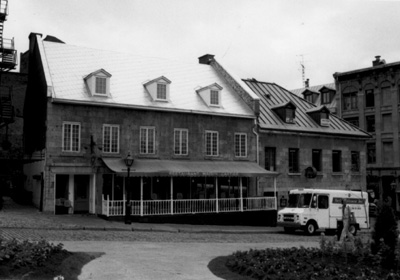Maison Cartier National Historic Site of Canada
Montréal, Quebec

Maison Cartier, 1982
© Parcs Canada | Parks Canada
Address :
407-413 Place Jacques-Cartier, Montréal, Quebec
Recognition Statute:
Historic Sites and Monuments Act (R.S.C., 1985, c. H-4)
Designation Date:
1982-11-19
Dates:
-
1812 to 1813
(Construction)
Event, Person, Organization:
-
Augustin Perrault
(Person)
-
Louis Parthenay
(Person)
-
Joseph Sicard Carufel
(Person)
-
Amable Amiot
(Builder)
Other Name(s):
-
Maison Cartier
(Designation Name)
-
Jardin Nelson
(Other Name)
Research Report Number:
1982-049; 2009-SDC-CED-058
Plaque(s)
Existing plaque: 407 Place Jacques-Cartier, Montréal, Quebec
Associated with hostelry for most of its existence, this stone building, constructed between 1812 and 1813 on what is now Place Jacques-Cartier, long served as an inn. It catered primarily to farmers and their customers, who were drawn to the neighbouring public market. Maison Cartier was representative of the small inns, very popular in the early 19th century, which were replaced by large hotels as cities expanded. Its proportions, rectangular plan, and gabled roof framed by firewalls exemplify the urban architecture of Quebec in the early 19th century.
Description of Historic Place
Maison Cartier National Historic Site of Canada is located on the east side of Place Jacques Cartier in Old Montréal, in Quebec. Built between 1812 and 1813, this two-and-a-half storey building is made of cut stone, with a gabled tinplate roof. The property also includes a rear yard and a stone block addition. Associated with the lodging industry for most of its existence, this house is one of the last small inns remaining in Canada. The official recognition refers to the legal property boundaries at the time of designation.
Heritage Value
Maison Cartier was designated as a National Historic Site of Canada in 1982 because: for most of its existence, it was associated with the history of inn keeping, it represents an example of the type of
building used as an inn and is one of the last remaining inns in a major city that were very popular in the early 19th
century; and it is an example of early 19th-century urban architecture in Quebec.
In 1808 a parcel of the property was transferred to the City of Montreal to develop a public market, the “New Marketplace,” known today as Place Jacques-Cartier. In the midst of this flurry of growth, Augustin Perrault and Louis Parthenay became involved in land speculation. The two associates purchased land in the New Marketplace and then on March 10, 1812, made an agreement with Amable Amiot to build two to three houses at the location. The first building completed was Maison Cartier. As soon as it was finished, it was rented out. One of its first occupants was Joseph Sicard Carufel, an innkeeper. Today, Maison Cartier is a restaurant and one of the last small inns still standing in Canada.
Maison Cartier is an example of a building used as an inn in the early 19th century, a very popular type of building at a time where travellers had to make frequent stops. Now covered with cut stone, it is endowed with a new gallery at street level. The ground floor is characterized by large windows and double doors on the left side. Six windows, arranged in a row, adorn the second floor and three accentuate the gabled roof. Covered in tinplate, the roof is closed in by firewalls that extend the gabled walls.
Source: Historic Sites and Monuments Board of Canada, Minutes, August 2009
Character-Defining Elements
Key elements contributing to the heritage value of this site are: its location on the east side of the Place Jacques-Cartier in Old Montréal, Quebec; its rectangular two-and-a-half-storey massing, clad in cut stone, topped with a gabled tinplate
roof and punctuated by three dormer windows on each side; the large multi-pane windows, arranged in rows; the double doors marking the lobby; the street-level gallery at the front; the firewalls that extend the thick gabled walls; its relation to the neighbouring buildings, several of which were also built by Amable Amiot and
were also used as inns in the 19th century; its current function, consistent with its original purpose.
Commemorative Intent
The Maison Cartier was designated a national historic site because:
• for most of its existence, it was associated with the history of inn keeping, it represents an example of the type of building used as an inn and is one of the last remaining inns in a major city that were very popular in the early 19th century; and
• it is an example of early 19th-century urban architecture in Quebec.
Source: HSMBC, SDC minutes, August 2009.